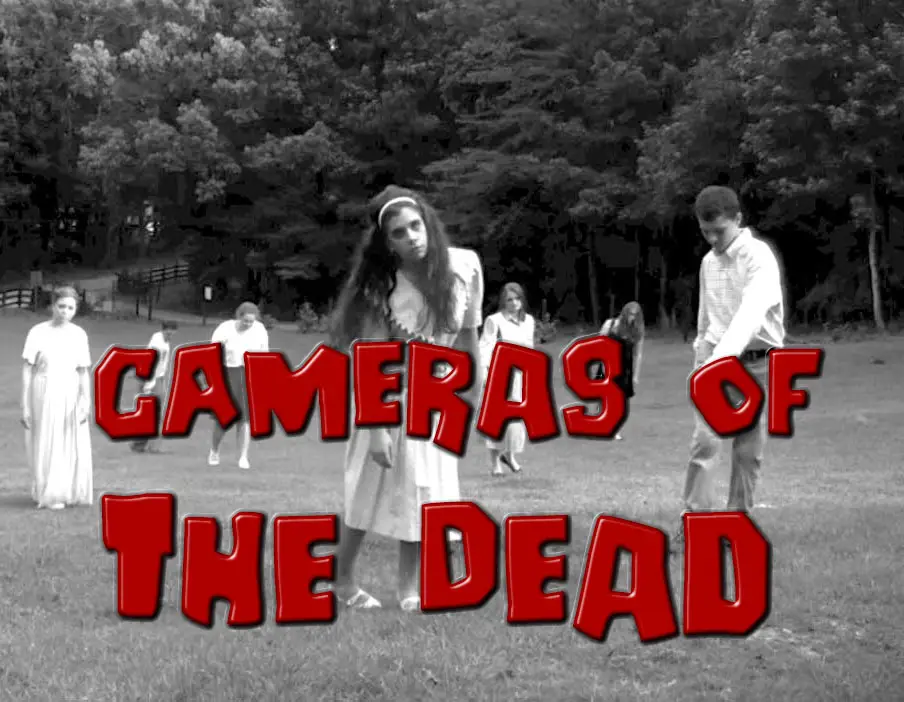 This review is part of the Cameras of the Dead series which I have been publishing every year on Halloween and “Halfway to” Halloween, featuring three cameras that I’ve wanted to review that either didn’t work, or was otherwise unable to shoot.
This review is part of the Cameras of the Dead series which I have been publishing every year on Halloween and “Halfway to” Halloween, featuring three cameras that I’ve wanted to review that either didn’t work, or was otherwise unable to shoot.
Last year, I republished individual versions of each of those reviews in the lead up to the 9th installment of the Cameras of the Dead series in October. This review is from that 9th edition, now finally getting it’s own single article indexable version.
This is a Traid Fotron, a unique point and shoot camera sold by the Traid Corporation of Glendale, California between 1962 and 1971, usually by door to door salesmen. The Fotron shot ten 1 inch by 1 inch exposures on unique Traid film cassettes that were filled with regular Kodak 828 film. The camera featured a built in electronic flash and a unique push button zone focus system that made it extremely simple to use. The camera was powered by a large capacitor inside of the camera that was recharged with regular 120 volt AC via a charging cord that plugs into the bottom. Although simple to use, the camera was sold at an incredibly high price and had shoddy build quality which resulted in a class action lawsuit that put the company out of business.

Film Type: Kodak 828 film loaded into proprietary Fotron “Snap-Load” Cassettes, (ten 1 inch x 1 inch exposures per roll)
Lens: 57mm f/4.5 Fotron anastigmat coated 3-elements
Focus: Three Zone Focus System (4-5 feet, 6-8 feet, 9-12 feet)
Viewfinder: Optical Scale Focus
Shutter: Rotary Metal Blade
Speeds: Single Speed, 1/60 second
Exposure Meter: None
Battery: No Battery, but the camera is powered by a large capacitor
Flash Mount: Built in Electronic Flash
Weight: 1148 grams
Manual: https://www.cameramanuals.org/pdf_files/fotron_traid_corp.pdf
The Worst Ever?
The Traid Fotron is one of the first cameras that most collectors think of when asked “What is the worst camera ever made”. The Fotron was a series of three models, all produced by the Traid Corporation of Glendale, California that was sold primarily by door to door salesmen and through back of magazine ads, using questionable sales tactics at prices way beyond what the camera was worth.
The first model in the series came in a gray body and was the only one directly marketed through retail sources. A repeated phrase used in most of Traid’s advertising is that the Fotron was the camera for people who loved Color Pictures, but hated Photography. Although it was never directly admitted to by the company, the Fotron’s target customer was women. In the advertisements above and in the camera’s instruction manual, women were most commonly seen using the camera.
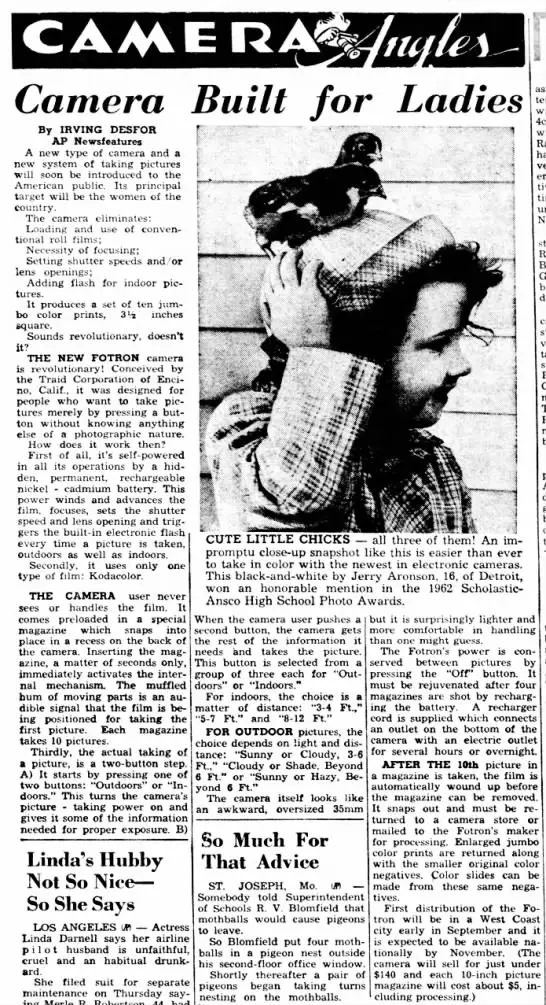
In the ad to the right from the September 9, 1962 issue of the Bryan, Texas Eagle, the camera is plainly referred to as the “Camera Built for Ladies”. The list of features sound pretty good, as it did simplify many parts of photography that might have seemed intimidating to novices of any gender. What’s more interesting is that the price of the camera at the bottom was claimed to be a reasonable $140 with each 10 exposure cassette running $5 including processing, a price much lower than later models were sold for.
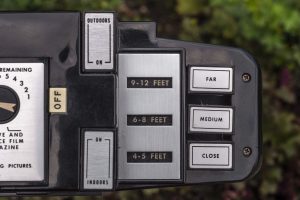
There were three different variants of the Fotron, the original with three focusing buttons and a gray body, a second with a black body and still three focusing buttons, and then a Fotron III that still had a black body, but only had two focusing buttons. Other than appearance and the number of focus buttons, everything else about all three Fotron cameras is the same.
Had the story ended with a strange looking camera that aimed to simplify photography with an easy to load snap-in film magazine, easy push button focus and flash control, automatic film transport, and an in body electronic flash for what would be an inflation adjusted price of $1200, the Fotron likely would not be considered one of the worst cameras ever made, but that’s not what happened.
At some point after the original model’s debut, the decision to stop retail sales and exclusively market the camera through mail order and door to door sales channels is where things went very wrong.
Although the history of who ran the Traid Corporation or who was responsible for the camera’s decisions is unclear, one of the men involved was former Traid president Kenneth M. Harden. Prior to working for Traid, Harden was a former senior vice president of the Encyclopædia Britannica company.
While there, Harden honed his skills as a high pressure salesman, learning tactics that allowed his sales staff to target unknowledgeable customers and trick them into paying way more for a product than common sense would otherwise suggest. Using these tactics, the sales staff at Traid reportedly sold thousands of Traid cameras to customers at ridiculously inflated prices.
In the scan above of the two page contract given to customers upon purchasing a Fotron camera, a large number of disclaimers are listed, the most interesting of which is that the camera is not free. I have never bought anything in my life where I needed to sign a contract that required me to understand that what I am purchasing is not free. Apparently this language was included in the contract as some Traid salespeople reportedly used tricks to make potential customers believe that the camera was, in fact free.
Even more disturbing is the break down of the price which appears to give customers the option of paying a cash price of $488, or enter into a payment plan requiring only a $10 down payment and then 29 monthly payments of $17.80 with a final month payment of $26.25.
Assuming a customer agreed to this and made all 30 monthly payments, after tax and interest, their total cost for buying the Fotron was an astounding $552.45 which when adjusted for inflation compares to $4600 today! For comparison, at that time, for less than the price of the Fotron, you could have spent your money at Webbs Photo in Palo Alto, CA on a Retina Reflex IV SLR with Schneider-Xenon f/1.9 lens for $278, a Rolleiflex 3.5F for $299.50, or a Leica M3 with the dual range Summicon f/2 lens for $486!
How to Use It
The Fotron was a large and heavy camera with sharp angles, huge swaths of plastic, and a large pleather hand strap on one side. It’s weight of 1148 grams (2.53lbs) actually is better than it could be as the camera’s entire body is plastic. I don’t even care to imagine how heavy this thing would have been had it been inside of a metal body.
The Fotron used proprietary Snap-Load magazines that had Kodak’s 828 roll film inside. The only film available was Kodacolor, meaning that the camera’s primitive exposure system could be tuned to this one film.
The Fotron produced ten 1 inch by 1 inch square images per cassette, and if you so chose, when sending your film to be developed, Traid could make 8 inch by 8 inch enlargements for an additional fee. The images the camera made were incredibly small compared to the comically large size of the camera.
Loading the Snap-Load magazines was very easy as all you needed to do was press it into place between two metal spring-loaded clamps. You didn’t even have to open a door like with an Instamatic camera, and upon inserting a new magazine, the camera would automatically advance it to the first exposure. After the last exposure, the camera would advance it past the paper trailer on the 828 film, so that you could safely remove it from the camera.
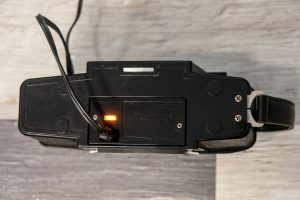
The Fotron has it’s own built in electronic flash which was powered not by a battery, but a huge beer can sized capacitor that was charged via an AC charging cord plugged into the camera’s base. Charging the camera took a minimum of 18 hours just to shoot one ten exposure magazine. If you wanted to try and shoot more than one magazine, the user manual advises charging the camera for 72 hours!
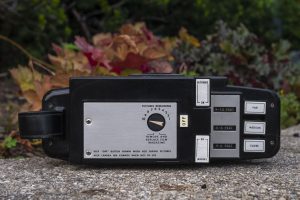
The top of the camera has an off switch, two power buttons, and three zone focus buttons that also double as the shutter release (there’s only two zone focus buttons on the Fotron III). With the camera off, a black curtain blocks light coming through the viewfinder, making it obvious the camera is off. Both the Indoors and Outdoors On switches turn the camera on and begin charging the flash and also change the focusing range between the focusing buttons. The Fotron’s manual strongly urges you to turn the camera off after every exposure to prolong it’s charge.
Before making an exposure, the manual advises you to wait at least 15 seconds for the camera to reach full power before attempting to fire the shutter. You will know when the camera is ready as two orange lamps on either side of the lens will flash five times. When it is time to make your exposure, the shutter is fired by pressing whichever of the three (two on the Fotron III) focusing buttons are appropriate for your subject. Once an exposure is made, the film is automatically advanced to the next exposure, up to ten, until you reach the end of the roll of film.
Perhaps the most unfortunate thing about the Fotron is that when you look past it’s goofy design and unscrupulous methods for how it was sold, there are a couple nice things I can say about it. For one, having a rechargeable in body electronic flash was actually a pretty cool feature for 1962 when this camera was first sold. Yes, other cameras had electronic flashes, but most beginner cameras still used flashbulbs. The flash was claimed to be rated at 30-watts and in theory could freeze motion like as if you had a faster shutter than you really did.
The gallery below of three images comes from Marcy Merrill’s Junk Store Cameras review of the Fotron in which Marcy picked up a camera with an included photo album with some photos shot with the camera. Images used with Marcy’s permission.
The Fotron’s 1 inch square exposures aren’t all that unreasonable, even if they’re dwarfed by the overall size of the camera. Each exposure covered an area of about 605 mm which compared to a standard 24mm x 36mm exposure from a regular 35mm camera was only 30% smaller. And with a decent triplet lens, enlargements of 8×8 were possible.
The idea of creating a camera that never needed batteries with a three-zone (later, two-zone) push button focus, with the simplest film loading sequence of any camera on the market, motorized film transport, and a built in electronic flash was actually a good one. You could forgive the huge size as electronics in 1962 were large in any gadget.
No one knows for sure how many Fotrons were sold, but it was said to be in the thousands. As I type this, a quick eBay search for “fotron camera” produces 43 cameras for sale, which suggests that a decent number of them are out there.
Where things went really wrong would later be revealed in a class-action lawsuit from the early 70s called Metowski v. Traid Corp in which 50 named plaintiff’s sued Traid on behalf of 100,000 owners, a number which is likely heavily inflated, accusing the company of misleading it’s customers.
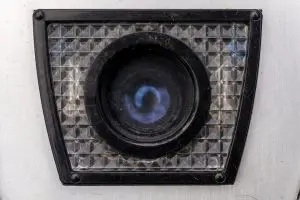
The lawsuit claims the camera was “highly overpriced, clumsy, with poor optical quality, and had few features to recommend”. In a statement regarding the camera being overpriced, it claims that the true value of the Fotron, when taking into account it’s features compared to similar cameras available at the same time to be only $40. How exactly this number was obtained is not clear. In the suit, the class asked for a full refund of the price of the camera, minus the fair value of $40, plus $5000 in damages. A second suit filed against Traid also asked for a refund, but only for $1000 in damages.
The article to the right from the April 25, 1971 issue of the Los Angeles Times describes high pressure sales tactics in which salesman remained in a potential customer’s house for as long as two hours, preying on a lack of knowledge by their sales prospects. One former Traid salesman confirms that at one point during his training, he was told to sell the camera with the idea that the camera would be free, a claim that Traid would deny.
With commissions as high as $175 per camera, the sales people had a huge incentive to push cameras on people. Back then, a $175 commission is comparable to over $1400 today after adjusting for inflation. If they only sold one camera per week, the commission was enough for that salesperson to live in comfort.
It is not clear what outcome this lawsuit had as my attempts to read the legal notes made my head spin. Claims by Traid saying the class-action suit was not valid suggest that it was decided in the plaintiff’s favor, but I honestly never made it to the end.
Whatever the case, the Traid Corporation ceased to exist at any time after this lawsuit and the company never made another photographic product again.
The gallery below shows a 4 page pamphlet produced for the Traid Fotron showing it’s “many virtues”. Whether this pamphlet was used as a marketing tool for sale in camera shops, or part of the literature given to potential customers in door-to-door sales is not known.
Related Posts You Might Enjoy
External Links
https://en.wikipedia.org/wiki/Fotron
http://www.junkstorecameras.com/project/traid-fotron/
https://www.photo.net/discuss/threads/the-abominable-traid-fotron.197208/

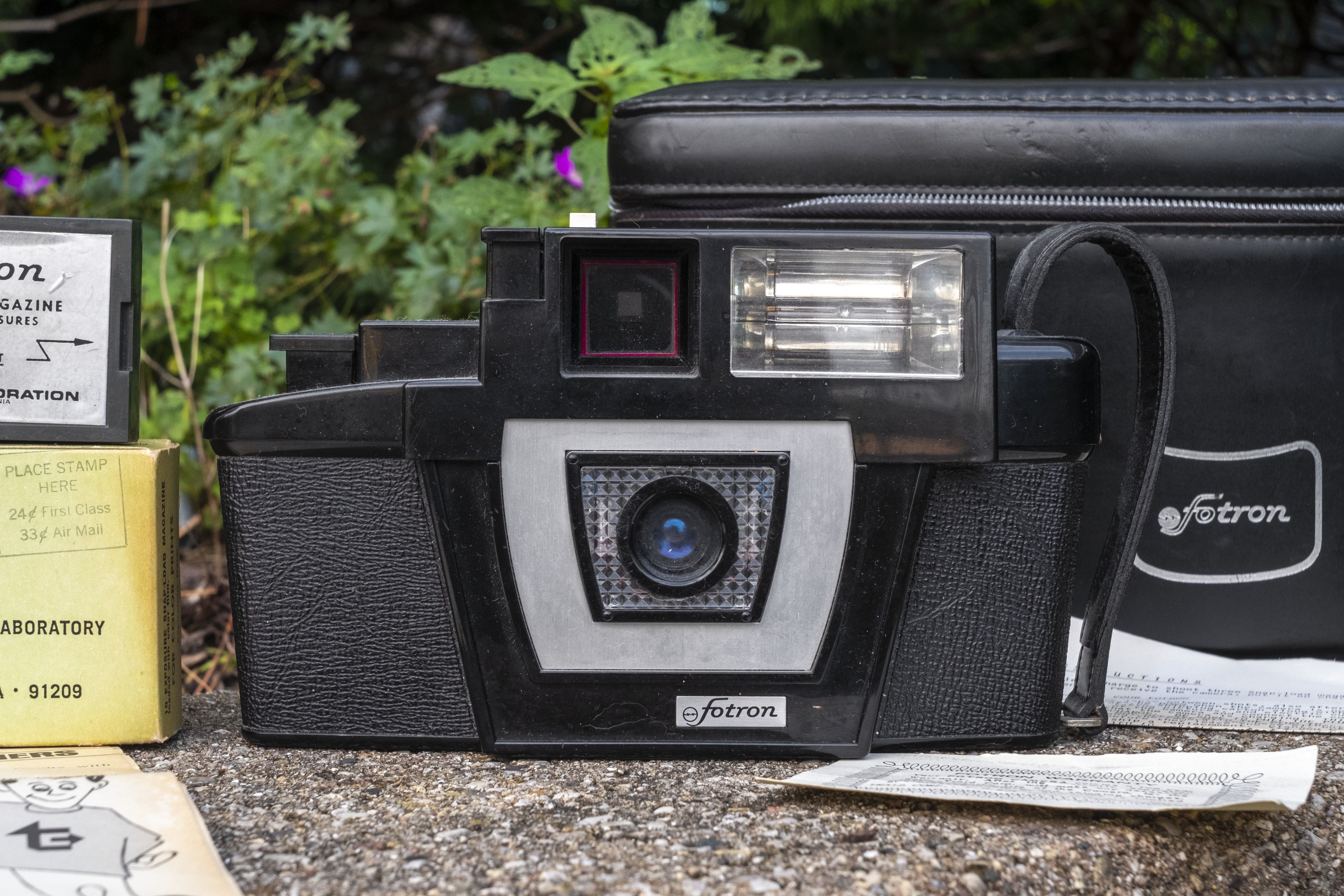
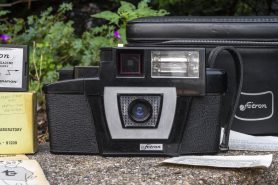
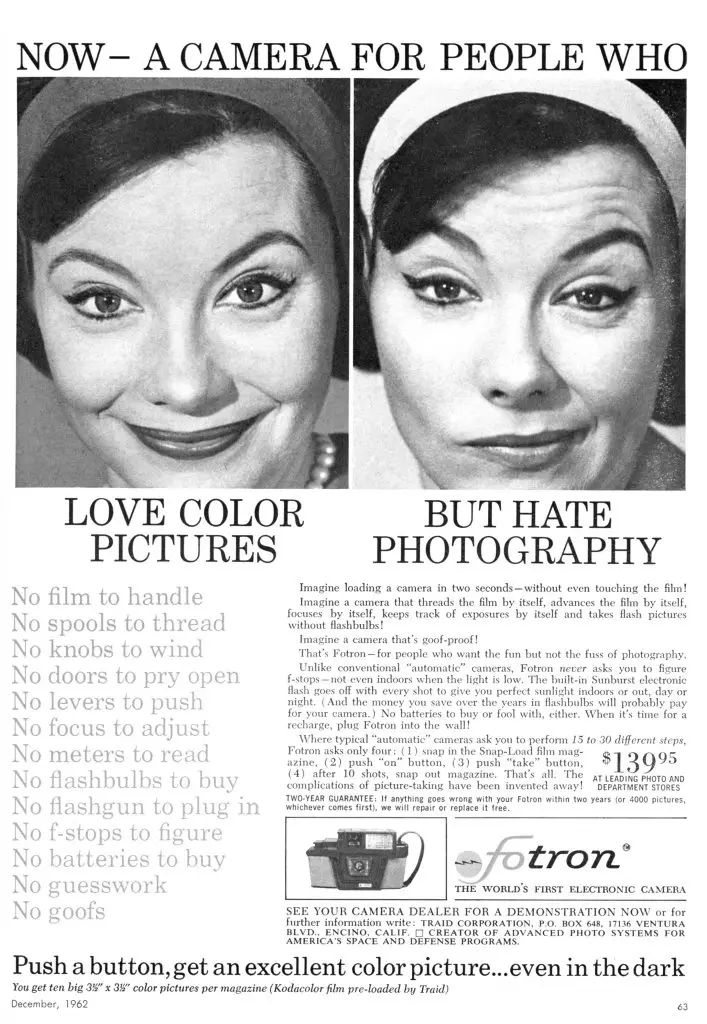
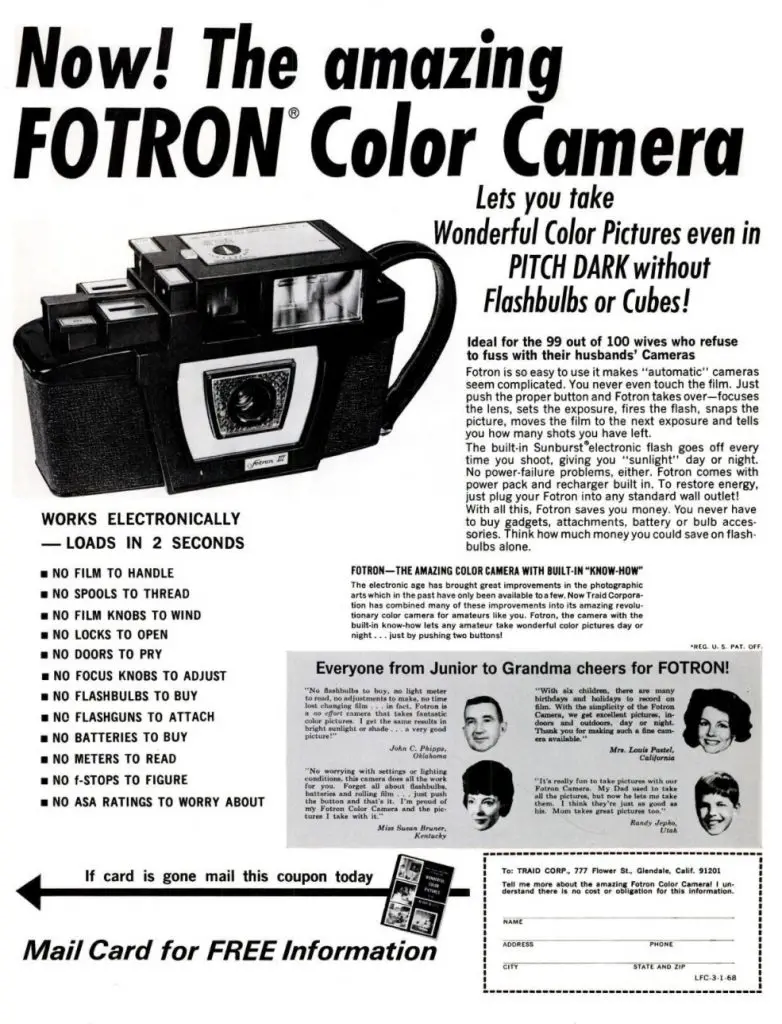
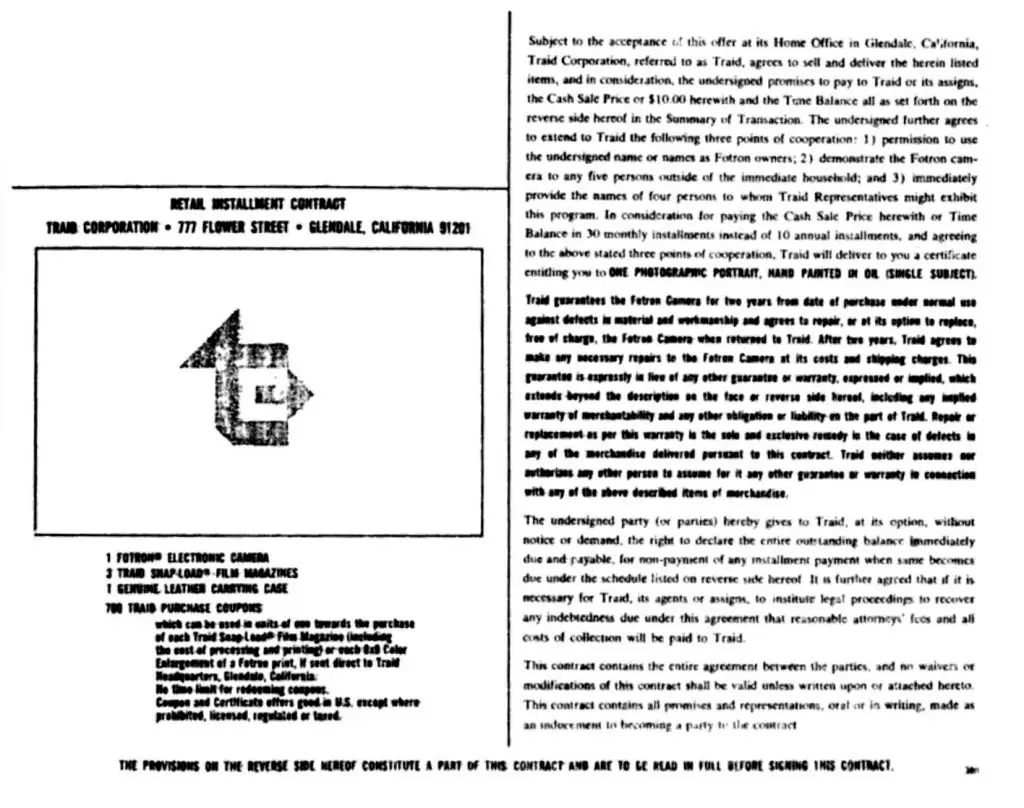
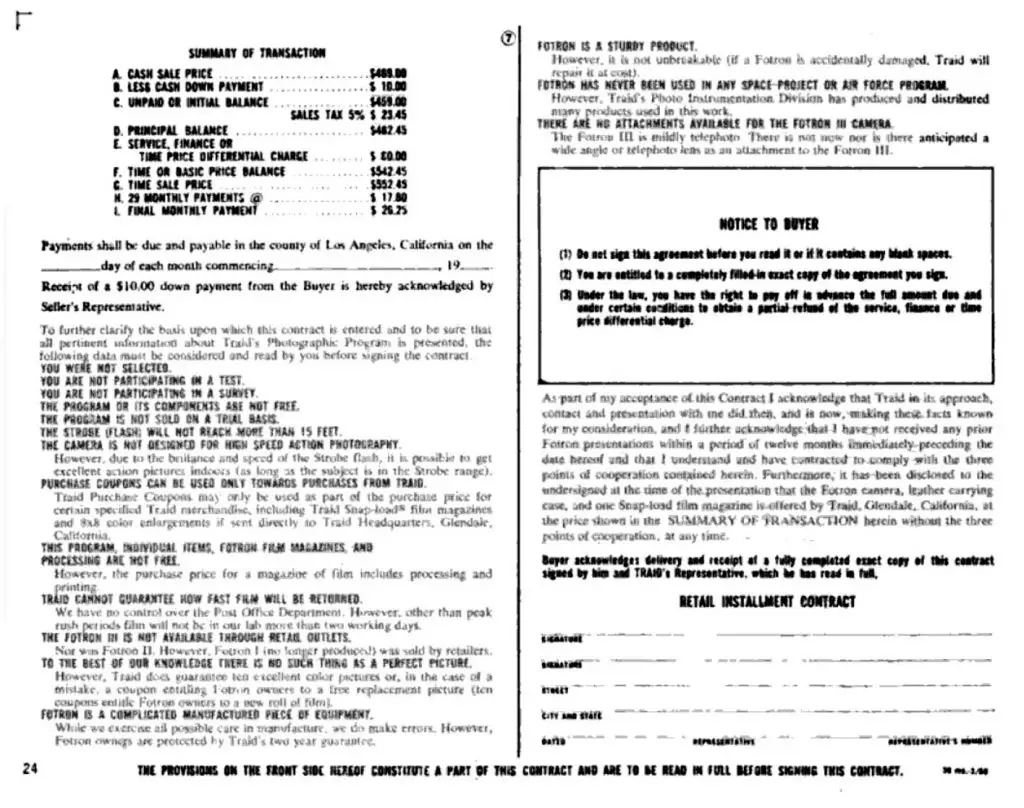
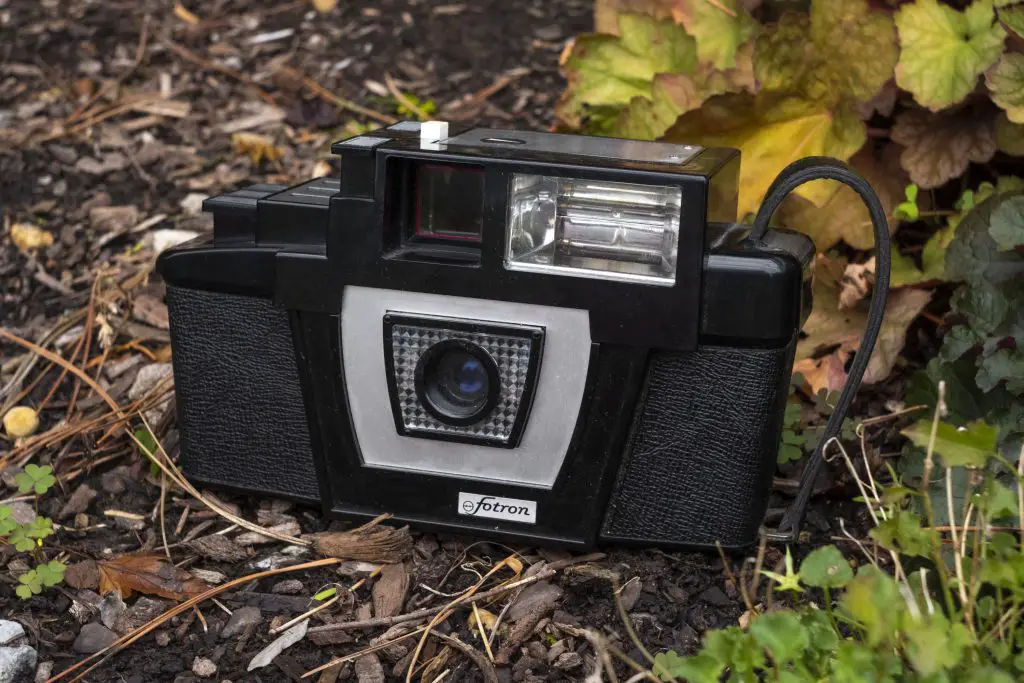
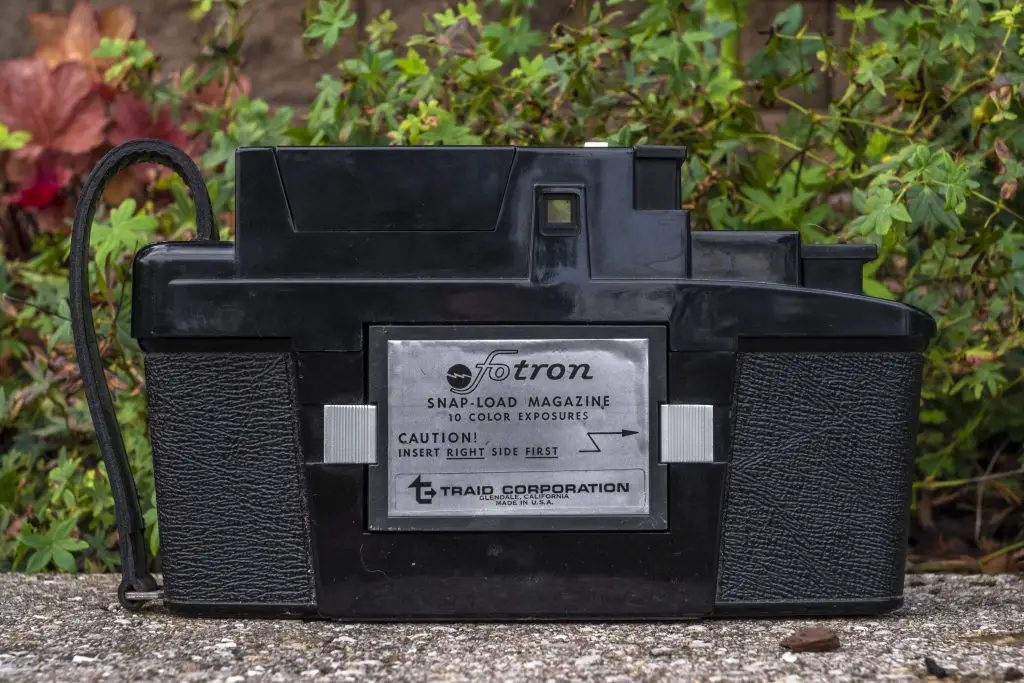
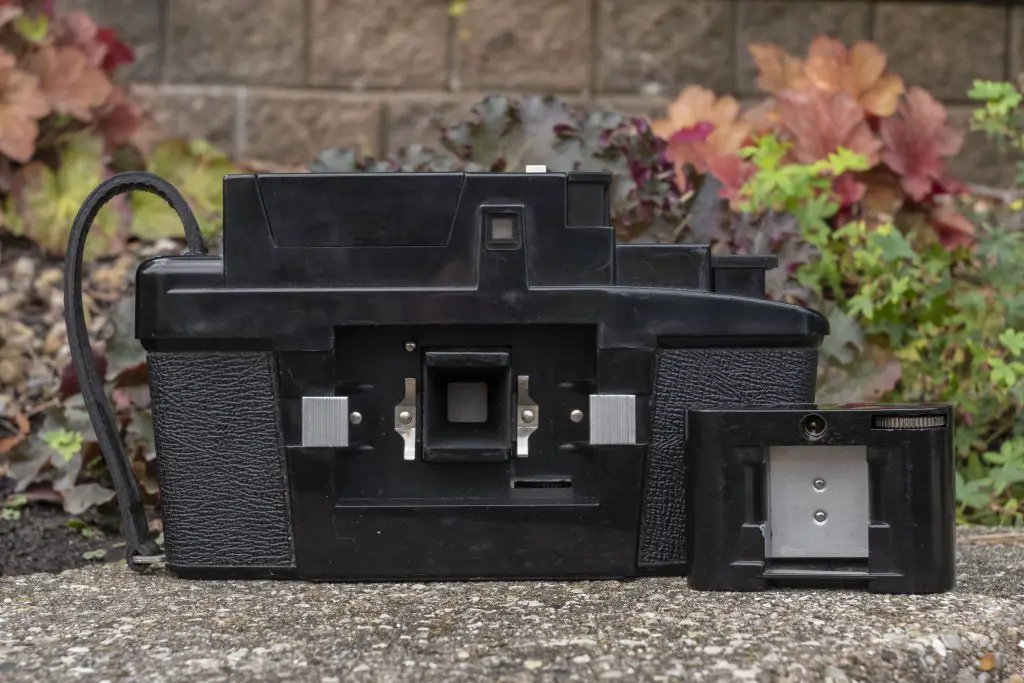
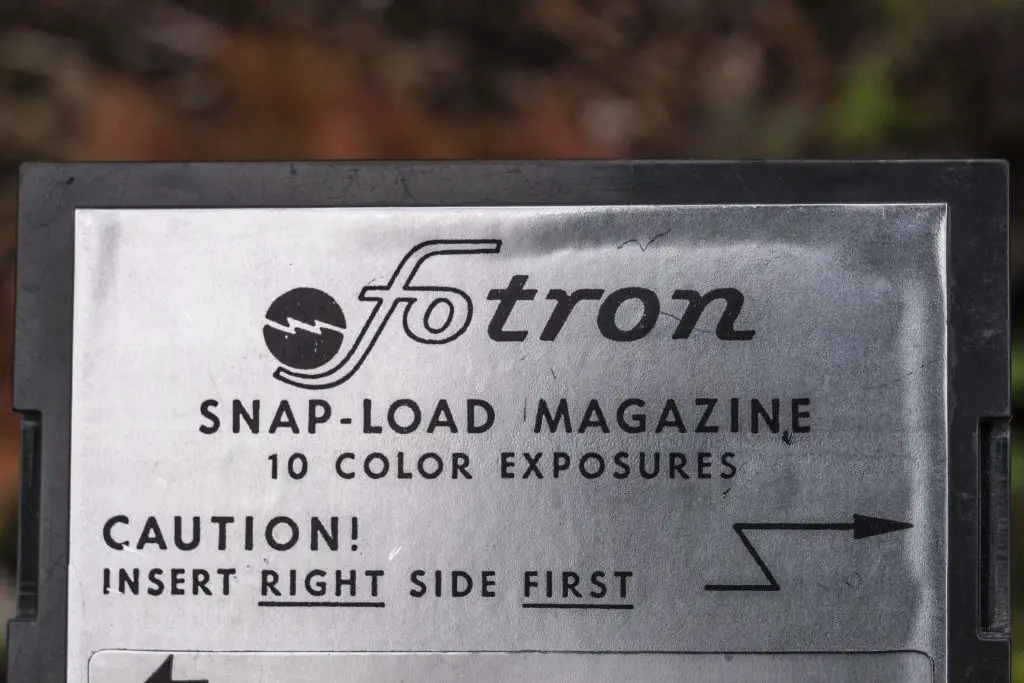
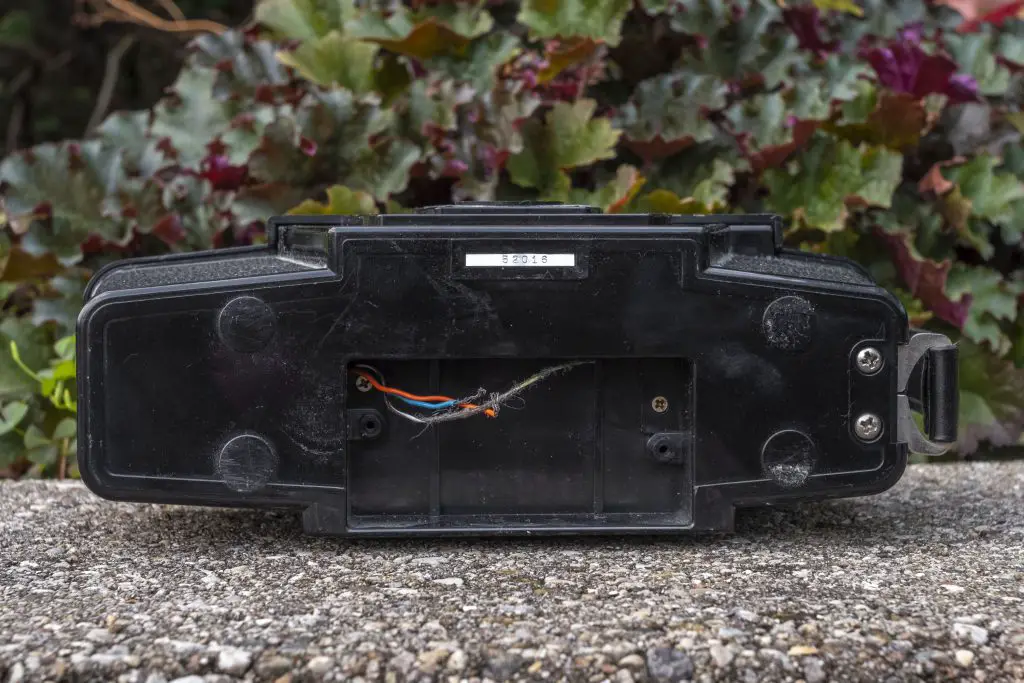
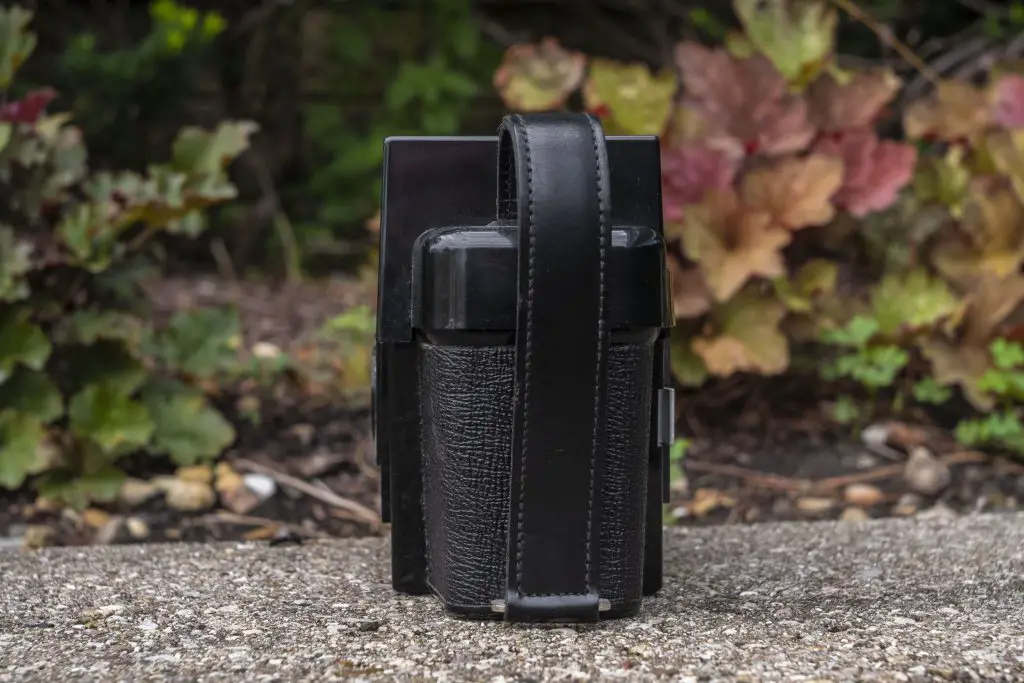
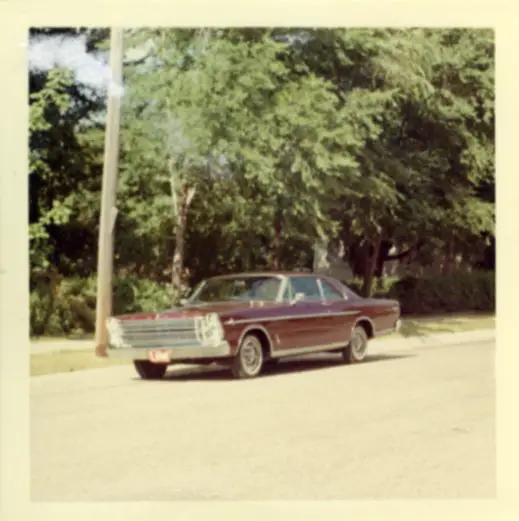

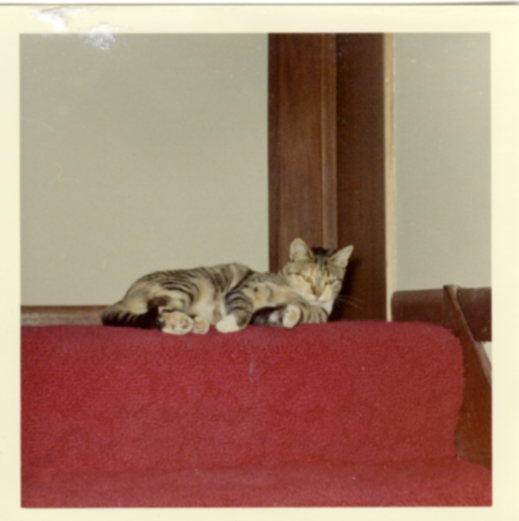

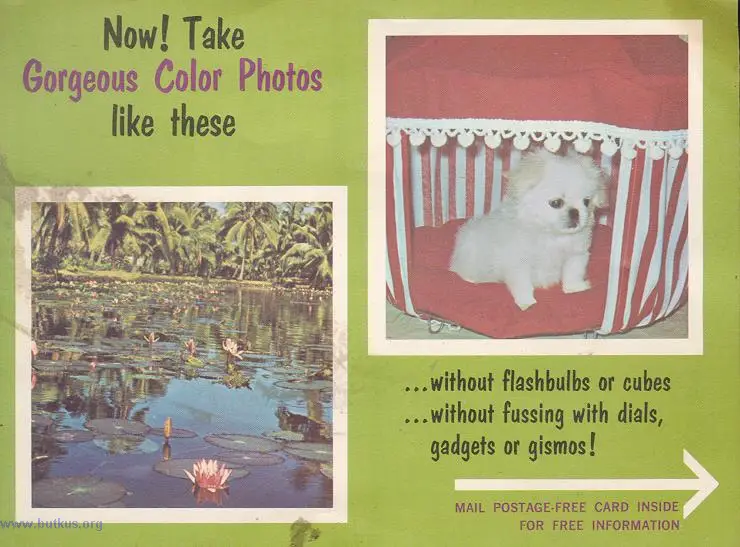
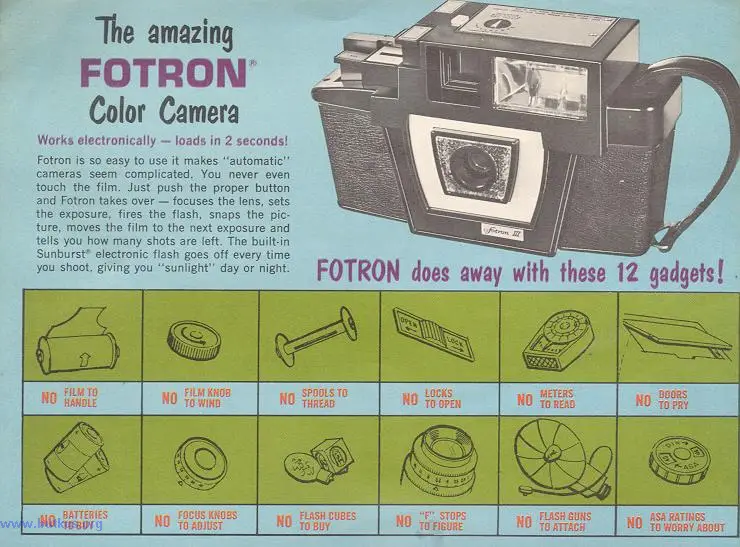

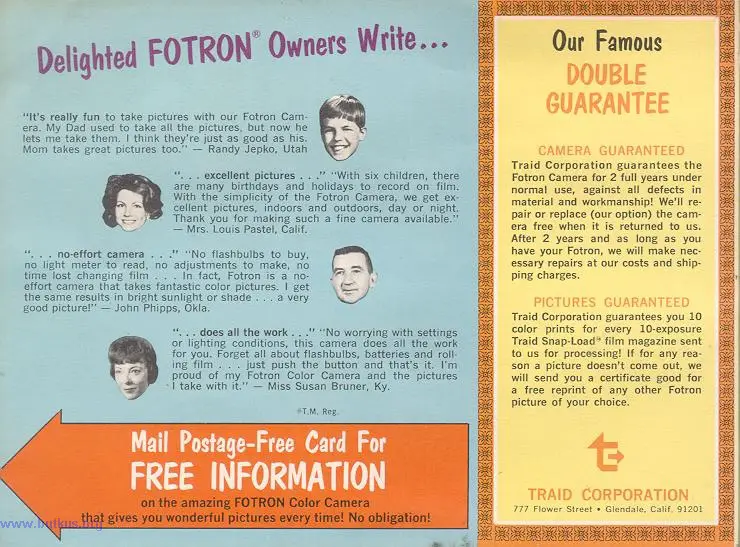
Hee-hee! I got one of these from shopgoodwill-dot-com — just to have one in my collection after reading a little about it. You found out a lot more than I did — but the thought of a camera with a capacitor which could rival a law-enforcement taser did have a certain appeal to me!!!! Thanks Mike — hope that you and the family had a good holiday break and have a great (and healthy) new year!!!
Number Two on the list of worst cameras ever: The Fotochrome, “for the remarkable Fotochrome color system”. Ad Dana did with the Fotron, I bought a NIOB Fotochrome from That Auction Site for about $15, just to have one in the collection. What some folks won’t do to empty the wallets of their fellow citizens …. Wishing you a healthy, peaceful and sane New Year!